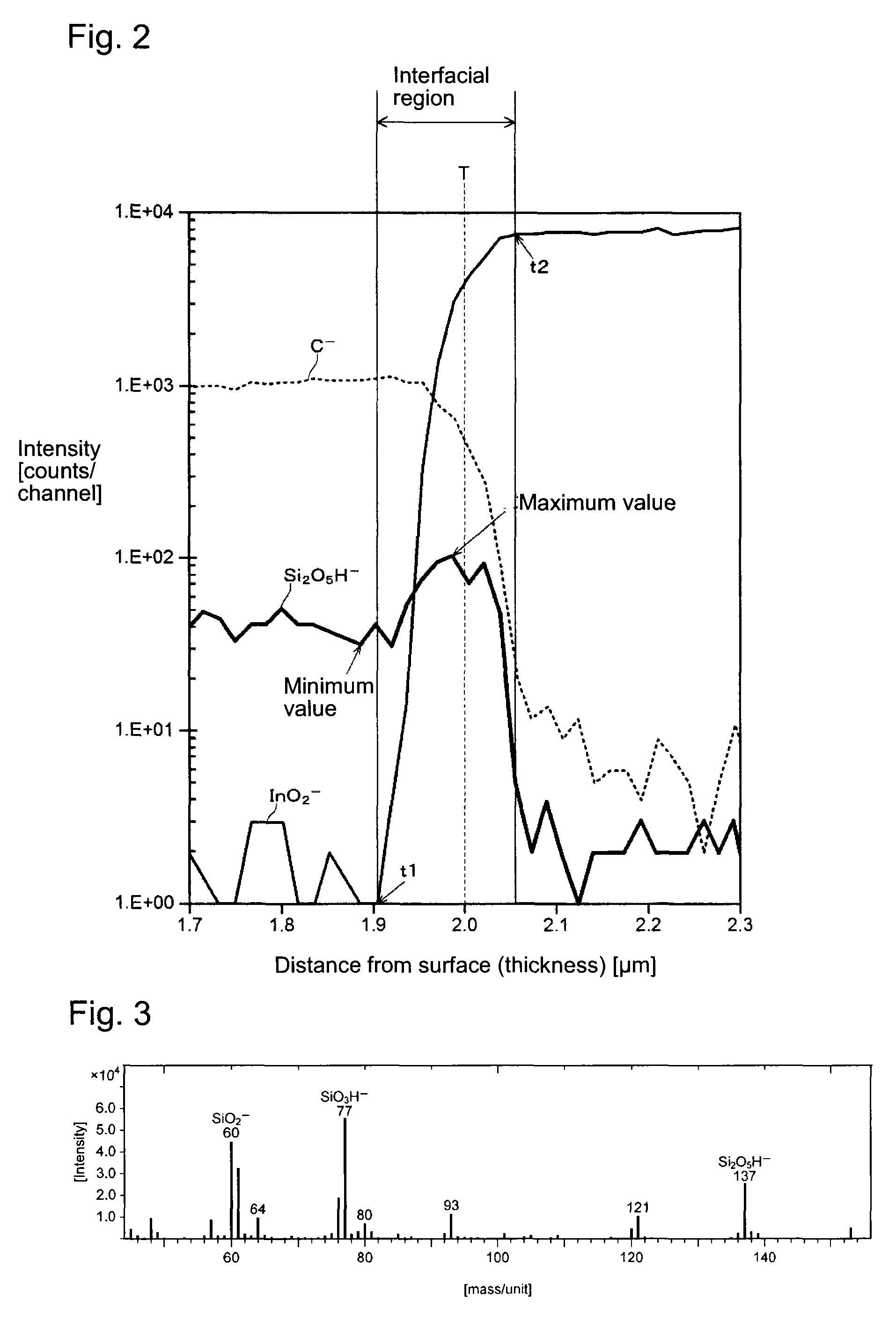Negative photosensitive resin composition, cured resin film, partition walls and optical element
a technology of resin composition and negative photosensitive resin, which is applied in the direction of photomechanical equipment, instruments, other domestic objects, etc., can solve the problems of inability to secure the ink-philicity of the opening section and the ink-repellency on the upper surface of the partition wall, and achieve good ink-repellency, good adhesion to the substrate, and good ink-repellency
- Summary
- Abstract
- Description
- Claims
- Application Information
AI Technical Summary
Benefits of technology
Problems solved by technology
Method used
Image
Examples
first embodiment
[Cured Resin Film in First Embodiment]
[0055]The cured resin film in the first embodiment of the present invention is a cured resin film formed on a substrate and having the following characteristics (I) to (III):
[0056](I) In a composition analysis by XPS (X-ray photoelectron spectroscopy), the ratio of the concentration of fluorine atoms to the concentration of carbon atoms at the surface of the cured resin film i.e. [F / C] is at least 0.1.
[0057](II) In a mass analysis in the thickness direction of the cured resin film by TOF-SIMS (time-of-flight secondary ion mass spectrometry) using Ar cluster as sputtering ions, the intensity profile of Si2O5H− has the maximum value in intensity in the interfacial region to the substrate as defined in the following (2) in the thickness range excluding the surface region of the cured resin film as defined in the following (1), and the ratio of the above maximum value in intensity to the minimum value in intensity in the thickness range excluding th...
second embodiment
[Cured Resin Film and Partition Walls in Second Embodiment]
[0394]The cured resin film in the second embodiment of the present invention is formed by using the above-described negative photosensitive resin composition of the present invention. The cured resin film in the second embodiment of the present invention may be obtained, for example, by applying the negative photosensitive resin composition of the present invention on the surface of a base material such as a substrate, and drying it to remove a solvent, etc., as the case requires, followed by exposure for curing. The cured resin film to be formed on a substrate by using the negative photosensitive resin composition of the present invention is a cured resin film within the scope of the cured resin film in the first embodiment of the present invention which has the characteristic (I) as a characteristic of the surface and the characteristic (II) as a characteristic in the interfacial region to the substrate, and also has the c...
synthesis example 1
Synthesis of Compound (D-1)
[0475]Into a 100 cm3 three necked flask equipped with a stirrer, 3 g of compound (cx-21) and 2.82 g of compound (cx-51) were put to obtain a mixture of hydrolysable silane compounds. Then, to this mixture, 17.5 g of PGME was added to obtain a raw material solution.
[0476]To the obtained raw material solution, 3.63 g of a 1% nitric acid aqueous solution was dropwise added. After completion of the dropwise addition, stirring was conducted at room temperature for 24 hours to obtain a PGME solution of compound (D-1) (concentration of compound (D-1): 10 mass %, hereinafter referred to also as “compound (D-1) solution”).
[0477]Further, after completion of the reaction, components of the reaction solution were measured by gas chromatography to confirm that the respective compounds as raw materials became lower than the detective limit.
[0478]The number average molecular weight (Mn) and mass average molecular weight (Mw) of obtained compound (D-1) were measured, and ...
PUM
| Property | Measurement | Unit |
|---|---|---|
| thickness | aaaaa | aaaaa |
| thickness | aaaaa | aaaaa |
| diameter | aaaaa | aaaaa |
Abstract
Description
Claims
Application Information
 Login to View More
Login to View More - R&D
- Intellectual Property
- Life Sciences
- Materials
- Tech Scout
- Unparalleled Data Quality
- Higher Quality Content
- 60% Fewer Hallucinations
Browse by: Latest US Patents, China's latest patents, Technical Efficacy Thesaurus, Application Domain, Technology Topic, Popular Technical Reports.
© 2025 PatSnap. All rights reserved.Legal|Privacy policy|Modern Slavery Act Transparency Statement|Sitemap|About US| Contact US: help@patsnap.com



